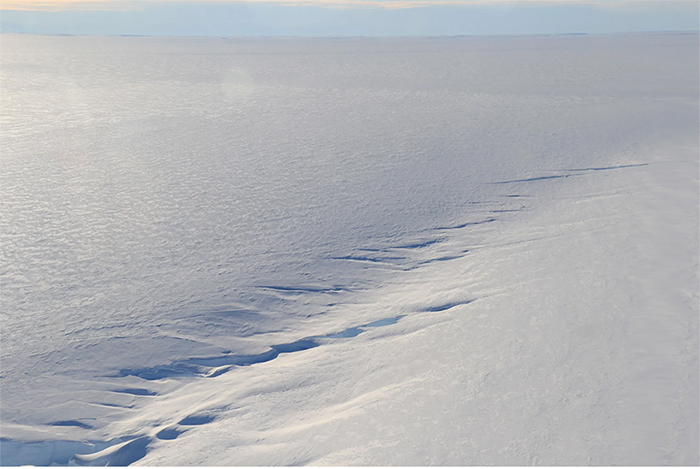
A portion of the Thwaites Glacier.
Erin Pettit
This story was originally published by Wired and is reproduced here as part of the Climate Desk collaboration.
Two Decembers ago, Erin Pettit layered up, slapped on goggles, cued up an audio book, and went on a hike—across Thwaites Glacier in Antarctica. Behind her, she dragged a sled loaded with a ground-penetrating radar, which fired pulses through a thousand feet of ice and analyzed the radio waves that bounced off the seawater below, thus building a detailed image of the glacier beneath her feet. Pettit—a glaciologist and climate scientist at Oregon State University—hiked alone through the snow, sometimes eschewing headphones for the absolute auditory stillness of the most remote landscape on Earth. “It was actually kind of an amazing, meditative field season,” she says, “I just bundled up, I went out there and pulled my sled, and just walked for miles and miles.”
In case you were worried, her colleagues always knew where Pettit was; every so often someone would roll out on a snow machine to bring her supplies or to swap out the radar’s battery. Sure, the team could have covered more ground by towing the radar behind the vehicle, but the vibrations would have introduced noise to the data. And by walking slowly, Pettit could maximize the resolution of the radar images. Every night, she’d return to camp, download that data, and begin to parse it. “And then the next day, I would go out and do the same thing—walk this peaceful, quiet walk,” says Pettit. She hiked up to 12 miles each day for over two weeks, for a total of 135 miles. “I was thinking: I’m walking on top of 300, 400 meters of ice that’s on top of the ocean, and on this piece of ice that was unlikely to be there for much longer.”
That’s because Thwaites—aka the Doomsday Glacier—is deteriorating fast, losing 50 billion tons of ice to the sea each year. Stretching 75 miles across the coast of Antarctica, encompassing an area about the size of Florida, it’s currently responsible for 4 percent of global sea level rise. (It straddles land and sea: The bit on land is known as an “ice sheet,” but where it floats it’s an “ice shelf.”) If it melted completely, the glacier would not only contribute over two feet of sea level rise, but as it slid into the ocean, it would also tug on the glaciers surrounding it, further destabilizing them. That’d add another eight feet of sea level rise.
Scientists are racing to understand how Thwaites is disintegrating, and to figure out how much time humanity has before the thing causes disastrous sea level rise. The ice shelf could crumble in three to five years, which will dramatically accelerate the decline of the rest of the glacier. Each new satellite image of Thwaites shows deeper and longer fractures that are growing up to six miles a year, and they’re heading toward thinner ice.
But the view from above only tells half the story. That’s why Pettit and 100 other scientists in the five-year International Thwaites Glacier Collaboration, funded by the US and UK governments, are also investigating the glacier’s hard-to-reach underbelly. At a meeting of the American Geophysical Union last month, they updated the public with their recent findings. And yeah, things aren’t looking good.
Pettit’s sled-based radar measurements give an idea of how well the glacier’s underside is holding together. Radar travels well through solid water but not liquid water, so when the pulses reached the sea—the relatively warm water that is melting the bottom of the glacier—they bounced back to the sled. “Where I’m walking looks like it’s just an endless flat landscape,” says Pettit. “But when you look at the underside, it’s a very intricate, complex landscape that has cliffs and gouges and fractures in it, and it’s much thinner than the rest of the ice shelf.”
Unlike the fractures that satellites have spotted on the surface, those underside cracks don’t seem to be growing quickly right now, Pettit says, “but they could easily be triggered to propagate faster.” That’s because the ice shelf is losing its grip on an underwater mountain about 30 miles offshore, which acts like a dam, or “pinning point,” holding back the rest of the glacier. But soon that dam will break and the ice shelf will shatter into icebergs. It’ll be like a car hitting a pothole, allowing a nick in the windshield to propagate into a web of cracks.
Without a cohesive ice shelf holding it back, the ice sheet on land will accelerate its own seaward march, as well as that of its neighbors. “As Thwaites Glacier loses mass and it flows out more quickly into the ocean, it will be pulling on the nearby glaciers,” says Pettit. Thus the name “Doomsday Glacier.”
Other scientists have turned their attention to Thwaites’ grounding zone, where the glacier transitions from land to floating on water. Peter Washam, an oceanographer and climate scientist at Cornell University, presented findings at the conference from his last few years of work. His team gets an even more detailed picture of the underside of the ice with a robot called Icefin, essentially an 11-foot-long scientific torpedo that a crew lowers through a bored hole. The robot’s tether allows it to wander over 2 miles, using sonar and lasers to map the seafloor and the glacier’s belly in three dimensions. It’s got sensors that measure salinity, temperature, and oxygen, and it uses acoustic pings that bounce off particles in the water column to measure the speed of currents. Basically, Icefin can track down whatever scientists want to know about Thwaites’ grounding zone. “It’s your typical ship-based instrumentation, all slammed into a little vehicle,” says Washam.
Getting a view of any grounding zone is a rarity. “The fact that it was Thwaites was like a gold star on top of that,” he continues. “This gives us an idea as we start to look around Antarctica elsewhere, and Greenland, of what we might expect in these sorts of regions.”
But the news from Icefin doesn’t bode well. Waters warm enough to melt glaciers are swirling around Thwaites’ grounding line—the exact point where ice meets land—and this line has retreated over a mile since 2011. That means there’s now more seawater in contact with the bottom of the glacier, which means more melting. The ice, says Washam, “is the most chaotic part of all of this—it has these really cool sort of corrugated, undulating features close to the grounding line.” These features are hot spots of melting.
If the underside of Thwaites were flat, the freshwater that melts out of the ice would pool beneath it like a lid, insulating it from being further melted by warmer seawater. “It will basically fight the movement of ocean heat into the ice,” says Washam. Instead, the undulating, sloped features disrupt the lid of freshwater, allowing warmer waters to contact the ice.
This revelation gives glaciologists critical insight into how glaciers everywhere might be degrading—and is a factor they haven’t yet accounted for in modeling. “This sort of other way of melting along these sloped ice surfaces is just not in ice sheet models,” Washam says. “What this shows us is this is something that has to be considered if we’re going to more accurately project Antarctica’s contribution to sea level rise.”
Lizzy Clyne, a geophysicist and glaciologist at Lewis and Clark College, and another conference presenter, has found yet more trouble at the grounding zone—by using explosives, which crews lower into a 20-foot-deep hole in the ice. (“It’s kind of like a firework,” Clyne says. “It would hurt you if it blew up in your hand, but it’s not like a giant bomb.”) An array of seismometers at the surface measures how the energy of the explosion bounces off what’s below the ice. Using that data, Clyne can see whether it’s water or solid earth. It works like Pettit’s ground-penetrating radar, and indeed Clyne marries the seismic data with radar data too.
The data, which Clyne has been gathering since 2018, is showing that because the ice shelf portion of Thwaites is floating on the sea, it tilts when the tide goes in and out. As it lifts up, warmer water slips through the grounding zone and underneath the ice sheet that’s resting on the land, driving still more melting. It’s yet another critical dynamic that isn’t represented in the modeling of glacial melt. “It’s got this kind of action where you might be pulling that couple-degrees-above-freezing seawater a little bit farther inland than we initially thought,” says Clyne. “It might be like a few centimeters of water, a little thin layer going farther inland. But that’s all it takes to melt ice.”
Now that scientists are piecing these trends together—the fractures in the ice shelf, the complexity of the underside of the glacier, and the tidal pumping—they’ve landed at a grim assessment of the Doomsday Glacier: It’s decomposing in more ways than they previously understood. If it melts entirely and takes surrounding glaciers with it, sea levels would go up a total of 10 feet. “In my view,” says Clyne, “if we’re going to have a very rapid amount of sea level rise over the next several decades, it can’t happen unless Thwaites is contributing a lot to it.”
By dragging radar on sleds, piloting torpedo robots, and setting off explosives, scientists are building an ever-clearer picture of the most important glacier on Earth. “I individually don’t have the ability to control sea level rise, and I can’t fix global warming on my own,” says Clyne. “But what we can do is study and understand what’s happening, what’s going to happen, and how to mitigate as much as possible.”















